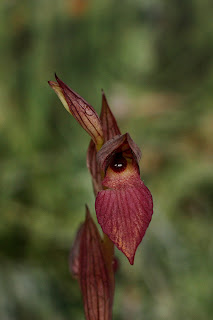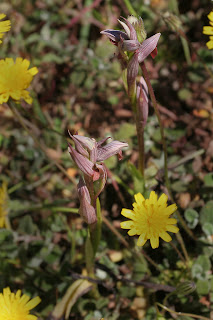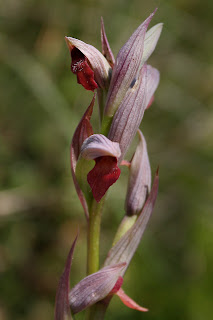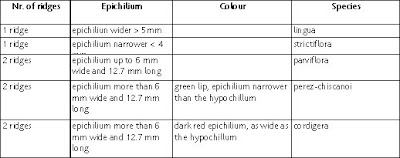One of the sub-species of Ophrys tenthredinifera, initially described as species by J.A. GUIMARÃES (1887) and now called Ophrys tenthredinifera subsp. ficalhoana (GUIMARÃES) M.R. LOWE & D. TYTECA.
This sub-species has the following characteristics:
- late flowering
- big and rather colourful flowers
- round sepals
- hair tuft in the lip just over the apex
Photos taken near Alenquer, Portugal, in April 2014.
Tuesday, October 14, 2014
Saturday, November 17, 2007
The man orchid – Aceras or Orchis ?
One the more common orchids in Portugal is known by “rapazinhos” and in English by “man orchid”.
The man orchid is a delicate orchid that grows to a height of between 15 and 30 cm. It is very easy to recognize by its basal rosette (all leaves are inserted at soil level), has 5-10 long lanceolate, spotless, leaves and by its small yellow-green stemless flowers with red stripes.
It is fairly common in Portugal, in the west limestone area, between the rivers Sado and Mondego, up to 60 km away from the sea, and also in the Algarve. Best places are Serras da Arrábida, d’Aire e Candeeiros, and Serra de Montejunto.
The man orchid used to be the only species of the monotypic genus Aceras - Aceras anthropophorum. It was first described by Carl von Linné in 1753 as Ophrys anthropophora but has been known since 1818 as Aceras anthropophorum (L.) W.T. Aiton.

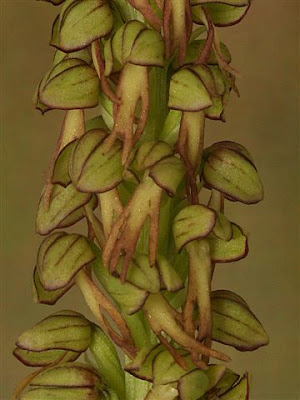 The flowers seem to have a bifid tongue ...
The flowers seem to have a bifid tongue ...Recently, for morphological reasons it has been renamed Orchis anthropophora, by DELFORGE and included in the Orchis group militaris, that in Portugal also includes Orchis italica. Molecular studies by BATEMAN also suggest the close relationship with other Orchis species.
The man orchid – Aceras or Orchis ?
Saturday, August 18, 2007
Serapias
The genus Serapias - the tongue orchids - are easily distinguished from other orchids by its distinctive characteristic - the tongue shapped lip.
Serapias lips - as with Epipactis and Cephalanthera -are distinctly divided into two parts separated by a constriction. The internal part is called hypochilium, and the external is called epichilium.
There are 5 species of tongue orchids reported in Portugal: perez-chiscanoi, vomeracea, strictiflora, lingua and parviflora. These Serapias species are distinguished mainly by the colour and the shape of the lip.

The presence of only one ridge on the basis of the lip diferentiates S. lingua and S. strictiflora from the other 3 species.
S. strictiflora has a hairy epichilium up to 4.5 mm wide, and is found in the centre and south of Portugal in open conditions on variable soils, often in homogeneous groups.
S. parviflora has the epichilium up to 6 mm wide and 12.7 mm long, while the other two - cordigera and perez-chiscanoi have epichiliuns wider than 8 mm and longer than 13 mm.
S. cordigera has dark red epichilium, as wide as the hypochillum, bracts shorter than the flowers, and is scatered throught Portugal.
Confused ? I will try to summarize:
Serapias lips - as with Epipactis and Cephalanthera -are distinctly divided into two parts separated by a constriction. The internal part is called hypochilium, and the external is called epichilium.
There are 5 species of tongue orchids reported in Portugal: perez-chiscanoi, vomeracea, strictiflora, lingua and parviflora. These Serapias species are distinguished mainly by the colour and the shape of the lip.
Adapted from Flora Iberica
The presence of only one ridge on the basis of the lip diferentiates S. lingua and S. strictiflora from the other 3 species.
aa
aa
S. lingua has a glabrous epichilium, wider than 5 mm and is found all over Portugal in open conditions.
S. strictiflora has a hairy epichilium up to 4.5 mm wide, and is found in the centre and south of Portugal in open conditions on variable soils, often in homogeneous groups.
S. parviflora has the epichilium up to 6 mm wide and 12.7 mm long, while the other two - cordigera and perez-chiscanoi have epichiliuns wider than 8 mm and longer than 13 mm.
S. perez-chiscanoi is a rare species only known in two areas in Alentejo, in rather humid, open habitat, and is the only one with green labellum and with the epichilium narrower than the hypochillum.
S. cordigera has dark red epichilium, as wide as the hypochillum, bracts shorter than the flowers, and is scatered throught Portugal.
S. parviflora, Serra de Montejunto, May 2007
Confused ? I will try to summarize:
as
My first orchid
The first orchid I spotted was a group of Barlia robertiana in Serra Daire e Candeeiros. It was raining cats and dogs, that day, but the huge orchids in an olive grove by the road side threw my attention.
Barlia robertiana is the biggest terrestrial Portuguese orchid, growing up to 1 meter high. It is one of the early flowering orchids, from January to April. The common names are “cravo-de-burro” (Portuguese) and “giant orchid” (English).
A comon species of grassy places, olive groves, citrus groves etc in the Mediterranean region, when most of the orchids are beginning to flourish, the Barlias are normally decaying in the seed stage.
xxx
Barlia robertiana is the biggest terrestrial Portuguese orchid, growing up to 1 meter high. It is one of the early flowering orchids, from January to April. The common names are “cravo-de-burro” (Portuguese) and “giant orchid” (English).
A comon species of grassy places, olive groves, citrus groves etc in the Mediterranean region, when most of the orchids are beginning to flourish, the Barlias are normally decaying in the seed stage.
xxx
In Portugal, Barlias exist in the West area, between the Sado and Mondego rivers, in a strip 60 km wide from the sea. Best places are Serra da Arrábida, Serra Daire e Candeeiros, Lisbon limestone surroundings that include Serra de Montejunto. Does not occur in the Algarve.
rtyrt
Introduction
Since March 2005, when I was fortunate enough to receive from Koeltz Book Company my copy of the amazing book from D. Tyteca The orchid flora of Portugal (see Book References), I have been travelling through Portugal searching for terrestrial orchids.
As the search is restricted in most places from beginning of March to the end of April and time is never enough for everything, in these 3 years I have searched 50 sites (some more than once), and found 35 orchid species. This number is around 40% of the total expected to be found in Portugal (around 70 species).
In May and even June there are some sites where orchids can still be found, normally located in altitude and / or in the half North of Portugal. I found references to one terrestrial orchid – Spiranthes spiralis – that flourishes end of September – October, and this is going to be one of my autumn projects for 2007.
As the search is restricted in most places from beginning of March to the end of April and time is never enough for everything, in these 3 years I have searched 50 sites (some more than once), and found 35 orchid species. This number is around 40% of the total expected to be found in Portugal (around 70 species).
In May and even June there are some sites where orchids can still be found, normally located in altitude and / or in the half North of Portugal. I found references to one terrestrial orchid – Spiranthes spiralis – that flourishes end of September – October, and this is going to be one of my autumn projects for 2007.
In my orchid hunting activity I try to combine research, travelling (which I enjoy a lot), walking and hiking, photography, and, why not, some tourist sightseeing and good meals.
lkjlkjlkj
Subscribe to:
Posts (Atom)











